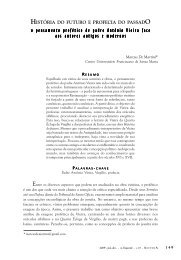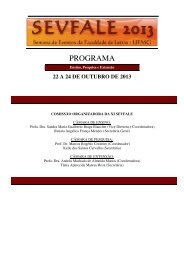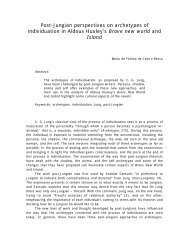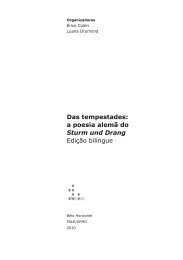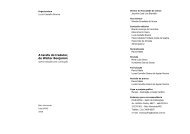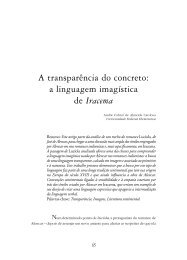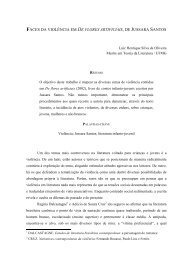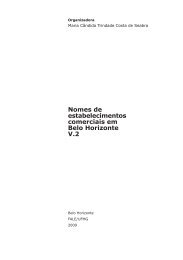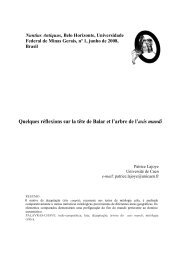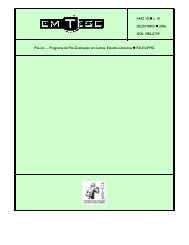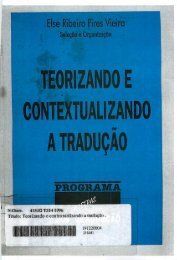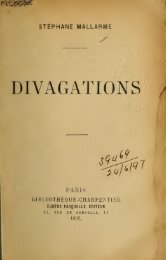E. E. Cummings: Modernist Painter and Poet
E. E. Cummings: Modernist Painter and Poet
E. E. Cummings: Modernist Painter and Poet
You also want an ePaper? Increase the reach of your titles
YUMPU automatically turns print PDFs into web optimized ePapers that Google loves.
10 Charles Spencer Chaplin, 1924. Ink<br />
drawing published in the Dial 76 (March<br />
1924): 248<br />
11 A Line Drawing, 1922. Ink drawing<br />
published in the Dial 72 (January 1922):<br />
46<br />
1923, the critic Gorham Munson<br />
concluded that "a complete study<br />
of <strong>Cummings</strong> should take pene-<br />
trating account of his painting <strong>and</strong><br />
drawing, <strong>and</strong> no estimate of his<br />
literary work can begin without<br />
noting the important fact that<br />
<strong>Cummings</strong> is a painter."14<br />
Just how thoroughly <strong>Cummings</strong><br />
himself believed this "fact," how-<br />
ever, is open to question. Despite<br />
his steady output of large abstrac-<br />
tions (at least fifteen by 1921), his<br />
early successes, <strong>and</strong> his declara-<br />
tions to his parents, peculiar<br />
lapses in his emerging career as a<br />
painter hint at professional uncer-<br />
tainty. For one thing, <strong>Cummings</strong><br />
was not aggressive in seeking ex-<br />
hibitions <strong>and</strong> one-artist shows in<br />
the 1920s, settling instead for a<br />
place in the yearly Independent<br />
exhibition. The Dial, of course,<br />
carried his line drawings to an in-<br />
fluential readership, but reproduc-<br />
tions in a magazine are no substi-<br />
tute for paintings in a gallery.<br />
Moreover, the mediocre quality of<br />
several drawings published in the<br />
Dial (e.g., fig. 11) suggests that<br />
Thayer <strong>and</strong> Watson may have<br />
placed personal friendship over<br />
their much-vaunted taste. Such<br />
preferential treatment could have<br />
stunted <strong>Cummings</strong>'s ability to criti-<br />
cize his own work, judgment he<br />
badly needed if no art teacher was<br />
to look over his shoulder. Equally<br />
important, after 1919 <strong>Cummings</strong><br />
did not generally associate with<br />
painters. Certainly he knew of the<br />
circle of Alfred Stieglitz (1864-<br />
1946) <strong>and</strong> probably visited<br />
Stieglitz's gallery "291," but he<br />
made no contacts with this impre-<br />
sario who might have arranged a<br />
one-artist show for him as he had<br />
done for so many other young<br />
<strong>Modernist</strong>s. Apart from Lachaise<br />
<strong>and</strong> his stepson, the painter<br />
Edward Nagle (1893-?),<br />
<strong>Cummings</strong>'s friends were nearly<br />
all writers or Harvard chums, <strong>and</strong><br />
he was aloof to gallery politics, a<br />
62 Spring 1990<br />
loner. His distrust of coteries may<br />
have prevented his making important<br />
contacts with other painters<br />
<strong>and</strong> patrons, but his distrust of<br />
himself probably explains his reluctance<br />
to seek out one-artist<br />
shows. He may not have felt<br />
ready yet.<br />
Such reluctance may also partly<br />
explain <strong>Cummings</strong>'s decision to<br />
leave America in 1921 <strong>and</strong> settle<br />
in Paris for the next three years.<br />
To judge from the hundreds of<br />
drawings he made abroad, he apparently<br />
felt the need to rethink<br />
his aesthetics <strong>and</strong> rework his techniques.15<br />
In Paris he had easy access<br />
to his favorite artists, <strong>and</strong> the<br />
sketch pad was a convenient place<br />
to work out compositional ideas<br />
gleaned from the Bernheim-Jeune<br />
Gallery <strong>and</strong> the Luxembourg Museum.<br />
But in America, <strong>Cummings</strong>'s<br />
painting virtually disappeared. The<br />
Sounds <strong>and</strong> Noises yielded to silence,<br />
<strong>and</strong> only a few of his watercolors<br />
were exhibited.<br />
At the same time, however,<br />
<strong>Cummings</strong>'s literary reputation<br />
blossomed with the publication of<br />
The Enormous Room in 1922, Tulips<br />
<strong>and</strong> Chimneys in 1923, <strong>and</strong><br />
poems in numerous little magazines.<br />
And unlike his abstract<br />
painting, which belonged to a<br />
broader modernist movement, his<br />
poems had indeed "done something<br />
FIRST," as he boasted to his<br />
father. His typographical innovations<br />
sparked an immediate <strong>and</strong><br />
lasting controversy, <strong>and</strong> <strong>Cummings</strong><br />
was soon known for them. Thus<br />
we find the potent irony that<br />
when he returned to America in<br />
December 1923, <strong>Cummings</strong> still<br />
considered himself "primarily a<br />
painter," as he wrote to his father,<br />
yet to a journalist reviewing his<br />
painting at the 1924 Independent<br />
exhibition, he was already "better<br />
known as a poet <strong>and</strong> novelist."16<br />
What heightens this irony is<br />
that <strong>Cummings</strong>'s painting had matured<br />
during his Parisian hiatus.



